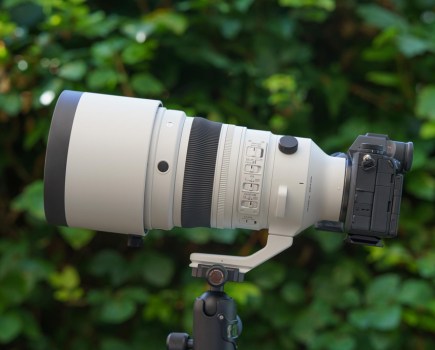Superzoom bridge cameras tend to be overlooked by enthusiast photographers; with their SLR-like design but small-sensor image quality, they’re often seen as sheep in wolves’ clothing. But the Canon PowerShot SX60 HS has a few features that make it stand out from the crowd, most notably raw-format image recording. It also has a frankly staggering 65x zoom range, which is as notable for its 21mm-equivalent wideangle setting as it is for its 1365mm-equivalent telephoto.
At £449, though, it’s more expensive than many of its competitors, and not far off entry-level DSLRs. But, of course, there’s no practical way of coming close to matching its zoom range with interchangeable lenses. Clearly there are going to be compromises with the superzoom camera, but is it still worthy of attention as a serious photographic tool?
Features
The SX60 HS is the successor to last-year’s SX50 HS, and aside from its aforementioned zoom, it gains notable updates in other areas. The sensor is now a 16.1-million-pixel back-illuminated CMOS unit – up from 12.1 million pixels – although it’s still the same small 1/2.3in type. The image processor is Canon’s newer DIGIC 6, but the maximum sensitivity has dropped to ISO 3200, compared to ISO 6400 on the SX50 HS. And despite the lens’s very impressive zoom range, its f/3.4-6.5 maximum aperture is disappointingly slow, especially as many of its competitors open up to f/2.8 at the widest end.
 To deal with the extended telephoto range, Canon says it has beefed up the lens’s optical image-stabilisation system. This may well be true, but we’ve found that merely aiming a 1365mm-equivalent lens in the right direction is a big ask – let alone holding it steady. Canon has provided a couple of framing assist functions for telephoto work, accessed by buttons on the lens barrel; the first temporarily zooms the lens out to allow you to re-acquire your subject, and the second soups up the IS to help with framing. These do help a bit, although neither is well placed for portrait-format shooting. Overall, at such long focal lengths, it’s best to use a tripod, or at the very least brace yourself against a wall.
To deal with the extended telephoto range, Canon says it has beefed up the lens’s optical image-stabilisation system. This may well be true, but we’ve found that merely aiming a 1365mm-equivalent lens in the right direction is a big ask – let alone holding it steady. Canon has provided a couple of framing assist functions for telephoto work, accessed by buttons on the lens barrel; the first temporarily zooms the lens out to allow you to re-acquire your subject, and the second soups up the IS to help with framing. These do help a bit, although neither is well placed for portrait-format shooting. Overall, at such long focal lengths, it’s best to use a tripod, or at the very least brace yourself against a wall.
The SX60 HS does have a reasonably good electronic viewfinder, with 922,000-dot resolution. The 3in rear LCD is fully-articulated, which is a rare treat these days; it can be pointed downwards, upwards or even directly forwards for self-portraits, and folded in to face the back of the camera to protect the screen. It has the same resolution as the EVF, but isn’t touch sensitive. Disappointingly, though, the SX60 HS lacks eye sensor; instead you have to press the DISP button to cycle between the EVF and LCD.
Other useful features include a hotshoe for attaching more powerful flash units. Built-in Wi-Fi with NFC allows for connecting to a mobile device for image sharing and remote shooting. Full HD movie recording at 1920×1080 resolution and 60fps is also on offer.
Build and handling
Canon PowerShot SX60 HS Review – Build and Handling
Like most cameras of this type the SX60 HS is styled like a miniature SLR, with a prominent handgrip and viewfinder housing on top. It fits very nicely in the hand, with a nicely shaped grip and moulded thumb rest on the back. On the whole, the controls are reasonably well laid out, too. The zoom controller encircles the shutter button, and the main control dial is placed immediately behind; this is used in conjunction with other buttons to change settings. The top plate is also home to the large power button and the exposure mode dial.
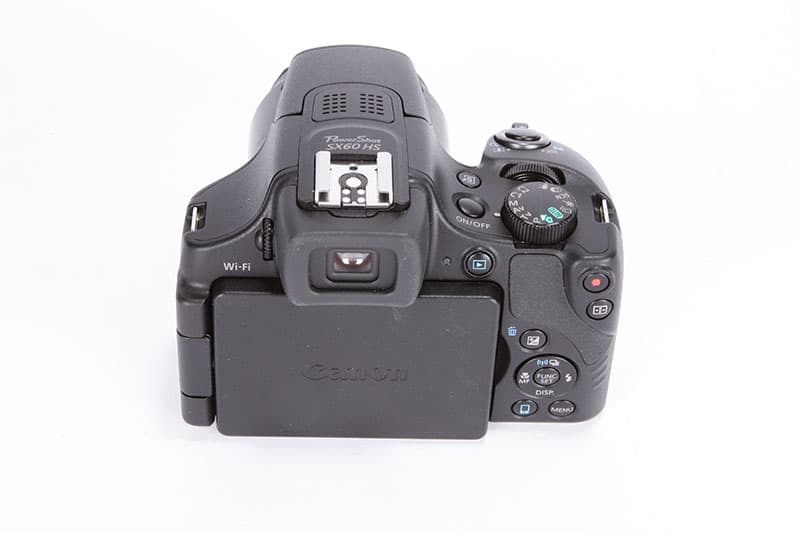 The buttons on the back of the camera give direct access to most of the key shooting parameters, including drive, flash and focus modes. They’re both decently sized and reasonably well spaced, making them relatively easy to operate with the camera to your eye. If we have a criticism, it’s that the four-way controller at the back of the camera is quite flush to the body, making it a little fiddly to operate, most notably when moving the focus area around the frame.
The buttons on the back of the camera give direct access to most of the key shooting parameters, including drive, flash and focus modes. They’re both decently sized and reasonably well spaced, making them relatively easy to operate with the camera to your eye. If we have a criticism, it’s that the four-way controller at the back of the camera is quite flush to the body, making it a little fiddly to operate, most notably when moving the focus area around the frame.
A shortcut button on the top of the camera can be customised to suit the user; oddly, it does nothing by default, but it can be set for such functions as autofocus lock or autoexposure lock. The movie record and framing assist buttons can also be re-assigned if you prefer, with a decent range of alternatives available. The handy onscreen function menu can also be user-customised, and the camera can memorise two custom exposure modes.
 Despite the resemblance to an SLR, however, the SX60 HS’s screens and menu options are resolutely from Canon’s PowerShot division. Some of the options are oddly dumbed down. For example, if you choose to shoot both raw and JPEG files together, the camera refuses to allow you to change any of the normally available JPEG parameters. There’s no way of setting the ISO aside from via Function menu, either.
Despite the resemblance to an SLR, however, the SX60 HS’s screens and menu options are resolutely from Canon’s PowerShot division. Some of the options are oddly dumbed down. For example, if you choose to shoot both raw and JPEG files together, the camera refuses to allow you to change any of the normally available JPEG parameters. There’s no way of setting the ISO aside from via Function menu, either.
In terms of build quality, the SX60 HS is very much in the middle of the road. Most of the body is constructed from lightweight plastics, with only the front fixed section of the lens barrel crafted from metal. There’s little here though to make the SX60 feel like a premium product, which is a bit disappointing given the price.
Performance
Canon PowerShot SX60 HS Review – Performance
 In terms of speed, the SX60 HS has something of a split personality. It starts up pretty quickly, with the lens extending ready for shooting inside a couple of seconds. The two-speed zoom can traverse the entirety of its range in a little over two seconds for quick framing, but at its slower speed it offers reasonably fine control over composition.
In terms of speed, the SX60 HS has something of a split personality. It starts up pretty quickly, with the lens extending ready for shooting inside a couple of seconds. The two-speed zoom can traverse the entirety of its range in a little over two seconds for quick framing, but at its slower speed it offers reasonably fine control over composition.
Continuous shooting is as fast as 6.4fps when recording JPEGs with the focus fixed at the start of a burst, but this falls to 3.4fps if continuous AF is turned on. However, the camera is rather slower if you shoot raw, at only about 2fps. Battery life is OK; we were able to get more than 300 shots from a full charge.
 Autofocus speed is okay outdoors under bright light. But as light levels fall, it becomes less and less decisive, especially at the long end of the zoom. In twilight, it can easily take a second or two to acquire focus, by which time your subject may have moved on; in really low light the camera is often unable to find focus at all.
Autofocus speed is okay outdoors under bright light. But as light levels fall, it becomes less and less decisive, especially at the long end of the zoom. In twilight, it can easily take a second or two to acquire focus, by which time your subject may have moved on; in really low light the camera is often unable to find focus at all.

Image Quality
Canon PowerShot SX60 HS Review – Image Quality
 Image quality is commensurate with what we’d expect from the small 1/2.3in sensor. It’s fine if you look at the picture as a whole, but doesn’t stand up to close examination of the pixels. Exposure and auto white balance tend to work pretty well, and colour rendition is pleasing enough, but the camera is pretty prone to clipping highlights in high-contrast situations. This can be combated using the Dynamic Range Correction setting, but only if you’re not shooting raw. The best image quality comes at sensitivities up to ISO 400; but while ISO 800 is usable at a pinch, ISOs 1600 and 3200 show severe loss of detail.
Image quality is commensurate with what we’d expect from the small 1/2.3in sensor. It’s fine if you look at the picture as a whole, but doesn’t stand up to close examination of the pixels. Exposure and auto white balance tend to work pretty well, and colour rendition is pleasing enough, but the camera is pretty prone to clipping highlights in high-contrast situations. This can be combated using the Dynamic Range Correction setting, but only if you’re not shooting raw. The best image quality comes at sensitivities up to ISO 400; but while ISO 800 is usable at a pinch, ISOs 1600 and 3200 show severe loss of detail.
Resolution
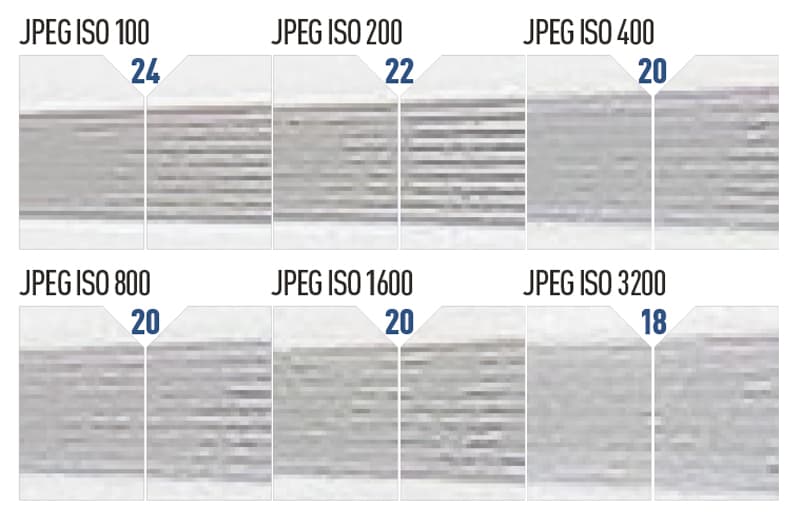 At ISO 100, the SX60 HS delivers around 2400 l/ph; this is quite low, given its 16-million-pixel sensor, and a direct consequence of its small imaging area. Resolution falls quickly as the sensitivity is increased, to around 2000 l/ph at ISO 400, and as low as 1600 l/ph at ISO 3200. This is well short of larger sensors with similar pixel counts.
At ISO 100, the SX60 HS delivers around 2400 l/ph; this is quite low, given its 16-million-pixel sensor, and a direct consequence of its small imaging area. Resolution falls quickly as the sensitivity is increased, to around 2000 l/ph at ISO 400, and as low as 1600 l/ph at ISO 3200. This is well short of larger sensors with similar pixel counts.
Dynamic Range
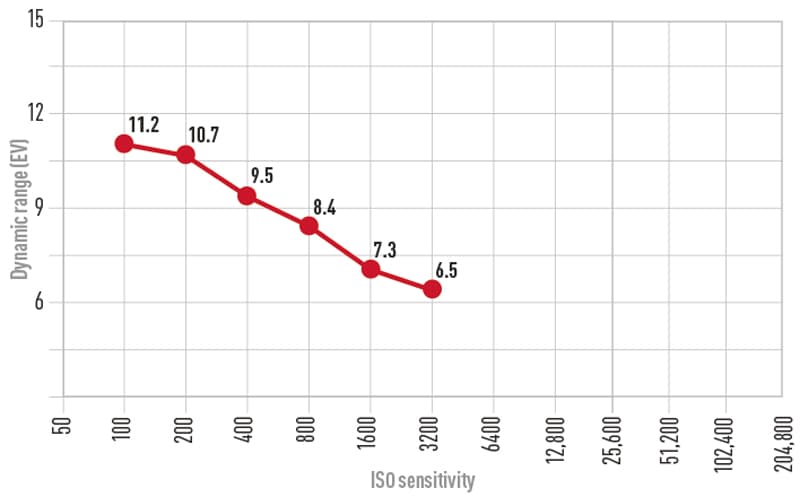 Base ISO DR is a perfectly reasonable 11.2 EV, but in practice you need to keep an eye on the exposure to avoid blowing highlights irretrievably. The small sensor quickly starts to struggle as the sensitivity is increased, and while 9.5 EV at ISO 400 is still quite usable, the low DR values at higher settings indicate distinctly limited shadow detail.
Base ISO DR is a perfectly reasonable 11.2 EV, but in practice you need to keep an eye on the exposure to avoid blowing highlights irretrievably. The small sensor quickly starts to struggle as the sensitivity is increased, and while 9.5 EV at ISO 400 is still quite usable, the low DR values at higher settings indicate distinctly limited shadow detail.
Noise
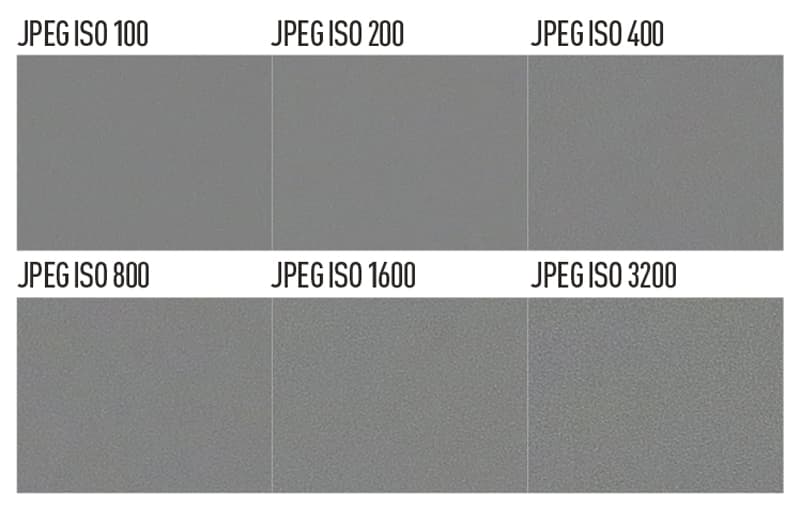 In terms of noise performance, the SX60 HS doesn’t do too badly, at least in these grey card crops. It’s pretty clean at ISO 100, and while a little luminance noise is visible at ISO 400, it’s scarcely intrusive. At the top ISOs, noise is very aggressively smoothed away, with just some low-frequency colour noise visible; but this inevitably comes at the expense of detail.
In terms of noise performance, the SX60 HS doesn’t do too badly, at least in these grey card crops. It’s pretty clean at ISO 100, and while a little luminance noise is visible at ISO 400, it’s scarcely intrusive. At the top ISOs, noise is very aggressively smoothed away, with just some low-frequency colour noise visible; but this inevitably comes at the expense of detail.
Verdict
Canon PowerShot SX60 HS Review – Verdict
If you don’t have overly high expectations of it, the SX60 HS isn’t too bad at all. In good light, the image quality is decent enough, although naturally it won’t match an SLR. The camera handles pretty well, with the EVF aiding shooting in bright light, and the vari-angle LCD gives plenty of flexibility in terms of shooting angles; however, the lack of an eye sensor for switching between them is a drawback. The vast 21-1365mm-equivalent zoom gives plenty of options, although we’ve found such an extreme telephoto to be difficult to use when shooting hand-held.
In more demanding shooting scenarios, though, the SX60 HS starts to show its limits. Faced with high contrast scenes, it’s prone to clipping highlights, and in low light, noise and detail loss becomes obvious at even quite moderate ISOs. Autofocus also leaves something to be desired, especially when light levels are falling. Overall, the SX60 HS is a competent enough performer for its class, but not much more than that.






